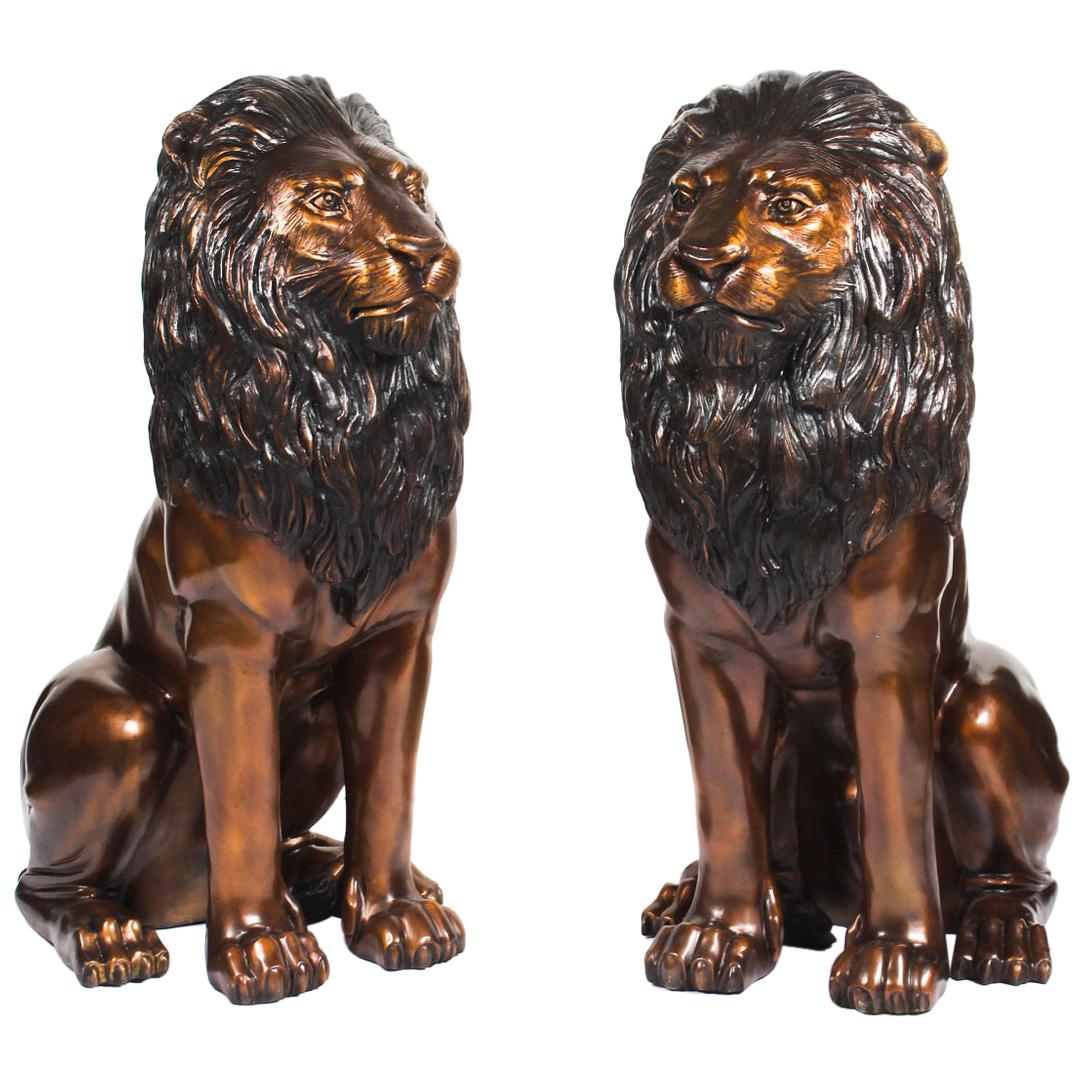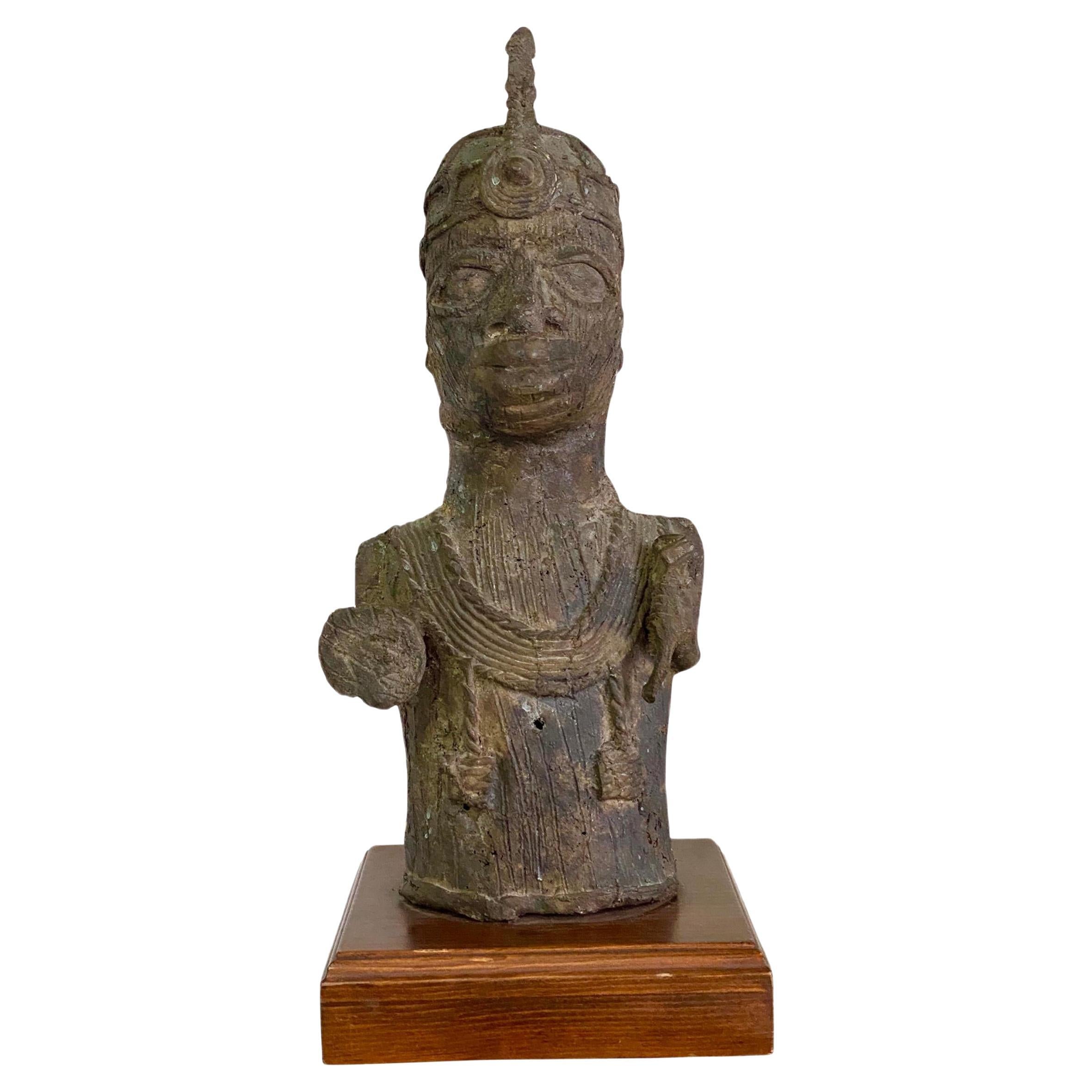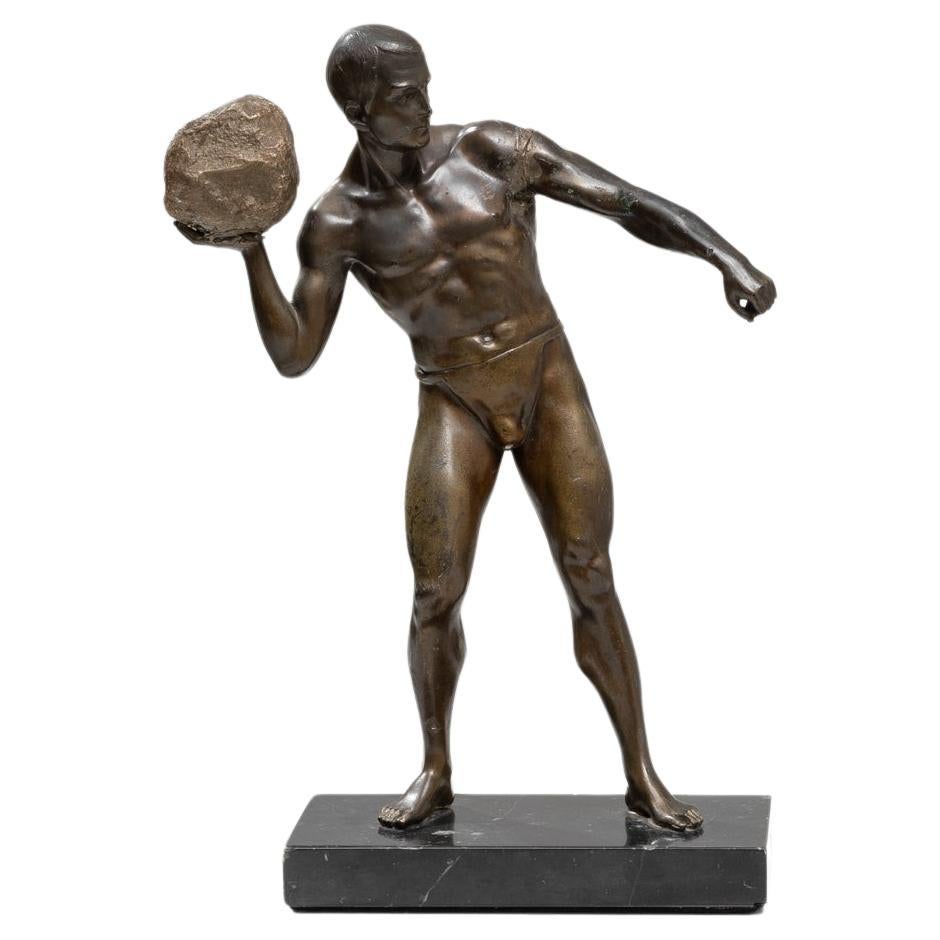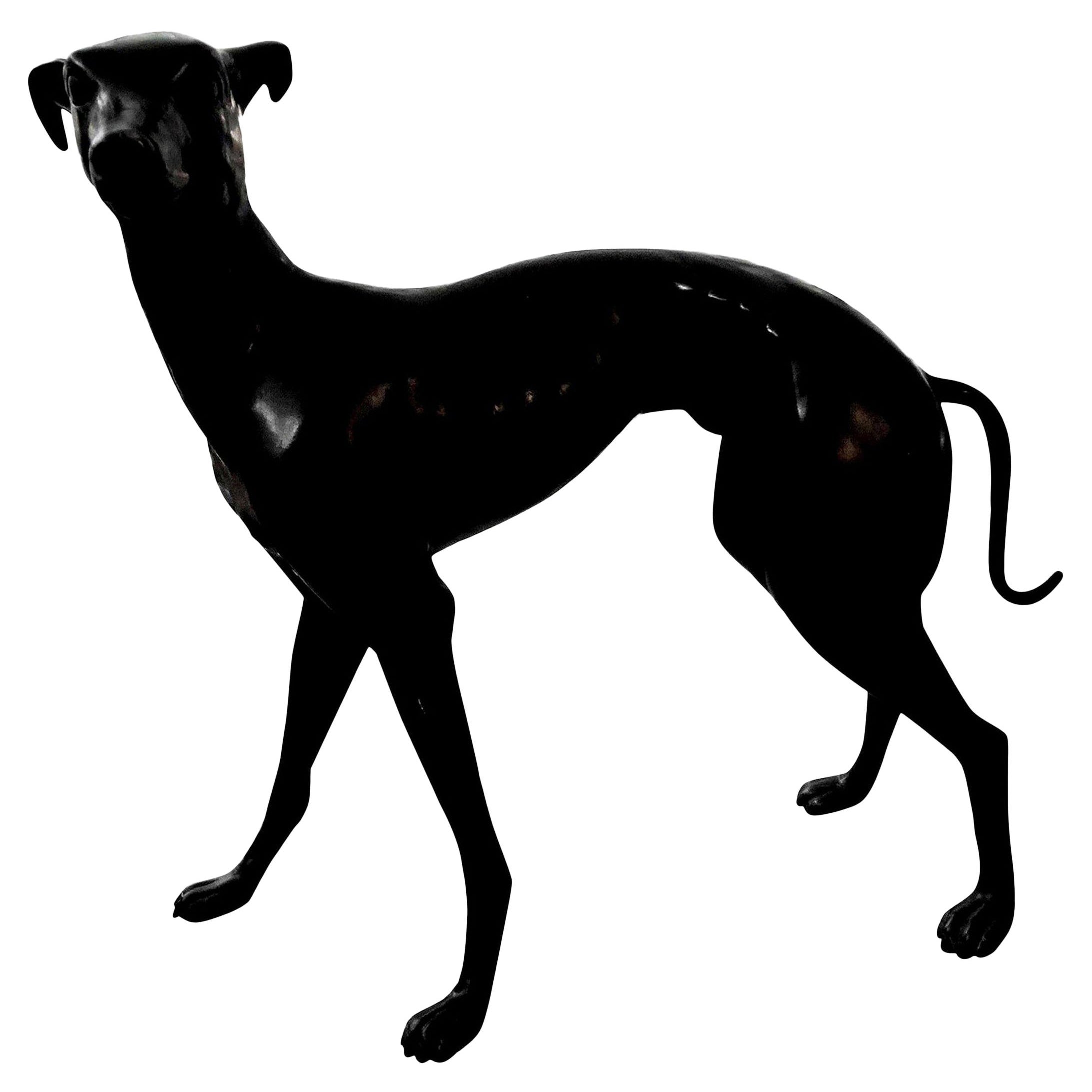Items Similar to Vintage Lifesize Bronze Sculpture of Seated Charlie Chaplin 20th Century
Want more images or videos?
Request additional images or videos from the seller
1 of 11
Vintage Lifesize Bronze Sculpture of Seated Charlie Chaplin 20th Century
About the Item
A truly stunning bronze sculpture of a seated Charlie Chaplin with his trademark cane, dating from the late 20th century.
The attention to detail is absolutely fantastic and really brings this piece to life all you need to add is the seat, bench or even a small plinth.
Add an elegant element to your garden with this lovely sculpture.
Condition:
In excellent condition, please see photos for confirmation of condition.
Dimensions in cm:
Height 137 cm x Width 56 cm x Depth 66 cm
Dimensions in inches:
Height 4 foot, 6 inches x Width 1 foot, 10 inches x Depth 2 foot, 2 inches
Charlie Chaplin Biography
Comedian (1889–1977)
Charlie Chaplin was a comedic British actor who became one of the biggest stars of the 20th century's silent-film era.
Synopsis
Born on April 16, 1889, in London, England, Charlie Chaplin worked with a children's dance troupe before making his mark on the big screen. His character "The Tramp" relied on pantomime and quirky movements to become an iconic figure of the silent-film era. Chaplin went on to become a director, making films such as City Lights and Modern Times, and co-founded the United Artists Corporation. He died in Corsier-sur-Vevey, Vaud, Switzerland, on December 25, 1977.
Early Life
Famous for his character "The Tramp," the sweet little man with a bowler hat, mustache and cane, Charlie Chaplin was an iconic figure of the silent-film era and one of film's first superstars, elevating the industry in a way few could have ever imagined.
Born Charles Spencer Chaplin in London, England, on April 16, 1889, Charlie Chaplin's rise to fame is a true rags-to-riches story. His father, a notorious drinker, abandoned Chaplin, his mother and his older half-brother, Sydney, not long after Chaplin's birth. That left Chaplin and his brother in the hands of their mother, a vaudevillian and music hall singer who went by the stage name Lily Harley.
Chaplin's mother, who would later suffer severe mental issues and have to be committed to an asylum, was able to support her family for a few years. But in a performance that would introduce her youngest boy to the spotlight, Hannah inexplicably lost her voice in the middle of a show, prompting the production manager to push the five-year-old Chaplin, whom he'd heard sing, onto the stage to replace her.
Chaplin lit up the audience, wowing them with his natural presence and comedic angle (at one point he imitated his mother's cracking voice). But the episode meant the end for Hannah. Her singing voice never returned, and she eventually ran out of money. For a time, Charlie and Sydney had to make a new, temporary home for themselves in London's tough workhouses.
Early Career
Armed with his mother's love of the stage, Chaplin was determined to make it in show business himself, and in 1897, using his mother's contacts, landed with a clog-dancing troupe named the Eight Lancashire Lads. It was a short stint, and not a terribly profitable one, forcing the go-getter Chaplin to make ends meet any way he could.
"I (was) newsvendor, printer, toymaker, doctor's boy, etc., but during these occupational digressions, I never lost sight of my ultimate aim to become an actor," Chaplin later recounted. "So, between jobs I would polish my shoes, brush my clothes, put on a clean collar and make periodic calls at a theatrical agency."
Eventually, other stage work did come his way. Chaplin made his acting debut as a pageboy in a production of Sherlock Holmes. From there he toured with a vaudeville outfit named Casey's Court Circus and in 1908 teamed up with the Fred Karno pantomime troupe, where Chaplin became one of its stars as the Drunk in the comedic sketch A Night in an English Music Hall.
With the Karno troupe, Chaplin got his first taste of the United States, where he caught the eye of film producer Mack Sennett, who signed Chaplin to a contract for a $150 a week.
Film Career
In 1914 Chaplin made his film debut in a somewhat forgettable one-reeler called Make a Living. To differentiate himself from the clad of other actors in Sennett films, Chaplin decided to play a single identifiable character, and "The Little Tramp" was born, with audiences getting their first taste of him in Kid Auto Races at Venice (1914).
Over the next year, Chaplin appeared in 35 movies, a lineup that included Tillie's Punctured Romance, film's first full-length comedy. In 1915 Chaplin left Sennett to join the Essanay Company, which agreed to pay him $1,250 a week. It is with Essanay that Chaplin, who by this time had hired his brother Sydney to be his business manager, rose to stardom.
During his first year with the company, Chaplin made 14 films, including The Tramp (1915). Generally regarded as the actor's first classic, the story establishes Chaplin's character as the unexpected hero when he saves the farmer's daughter from a gang of robbers.
By the age of 26, Chaplin, just three years removed from his vaudeville days, was a superstar. He'd moved over to the Mutual Company, which paid him a whopping $670,000 a year. The money made Chaplin a wealthy man, but it didn't seem to derail his artistic drive. With Mutual, he made some of his best work, including One A.M. (1916), The Rink (1916), The Vagabond (1916) and Easy Street (1917).
Through his work, Chaplin came to be known as a grueling perfectionist. His love for experimentation often meant countless takes, and it was not uncommon for him to order the rebuilding of an entire set. Nor was it uncommon for him to begin filming with one leading actor, realize he'd made a mistake in his casting and start again with someone new.
But the results were hard to refute. During the 1920s Chaplin's career blossomed even more. During the decade he made some landmark films, including The Kid (1921), The Pilgrim (1923), A Woman in Paris (1923), The Gold Rush (1925), a movie Chaplin would later say he wanted to be remembered by, and The Circus (1928). The latter three were released by United Artists, a company Chaplin co-founded in 1919 with Douglas Fairbanks, Mary Pickford, and D.W. Griffith.
Off-Screen Drama
Chaplin became equally famous for his life off-screen. His affairs with actresses who had roles in his movies were numerous. Some, however, ended better than others.
In 1918 he quickly married 16-year-old Mildred Harris. The marriage lasted just two years, and in 1924 he wed again, to another 16-year-old, actress Lita Grey, whom he'd cast in The Gold Rush. The marriage had been brought on by an unplanned pregnancy, and the resulting union, which produced two sons for Chaplin (Charles Jr. and Sydney) was an unhappy one for both partners. They divorced in 1927.
In 1936, Chaplin married again, this time to a chorus girl who went by the film name of Paulette Goddard. They lasted until 1942. That was followed by a nasty paternity suit with another actress, Joan Barry, in which tests proved Chaplin was not the father of her daughter, but a jury still ordered him to pay child support.
In 1943, Chaplin married 18-year-old Oona O'Neill, the daughter of playwright Eugene O'Neill. Unexpectedly the two would go on to have a happy marriage, one that would result in eight children.
Later Films
Chaplin kept creating interesting and engaging films in the 1930s. In 1931, he released City Lights, a critical and commercial success that incorporated music Chaplin scored himself.
More acclaim came with Modern Times (1936), a biting commentary about the state of the world's economic and political infrastructures. The film, which did incorporate sound, was, in part, the result of an 18-month world tour Chaplin had taken between 1931 and 1932, a trip during which he'd witnessed severe economic angst and a sharp rise in nationalism in Europe and elsewhere.
Chaplin spoke even louder in The Great Dictator (1940), which pointedly ridiculed the governments of Hitler and Mussolini. "I want to see the return of decency and kindness," Chaplin said around the time of the film's release. "I'm just a human being who wants to see this country a real democracy . . ."
But Chaplin was not universally embraced. His romantic liaisons led to his rebuke by some women's groups, which in turn led to him being barred from entering some U.S. states. As the Cold War age settled into existence, Chaplin didn't withhold his fire from injustices he saw taking place in the name of fighting Communism in his adopted country of the United States.
Chaplin soon became a target of the right-wing conservatives. Representative John E. Rankin of Mississippi pushed for his deportation. In 1952, the Attorney General of the United States obliged when he announced that Chaplin, who was sailing to Britain on vacation, would not permitted to return to the United States unless he could prove "moral worth." The incensed Chaplin said good-bye to United States and took up residence on a small farm in Corsier-sur-Vevey, Switzerland.
Final Years
Nearing the end of his life, Chaplin did make one last visit to the United States in 1972, when he was given an honorary Academy Award. The trip came just five years after Chaplin's final film, A Countess from Hong Kong (1967), the filmmaker's first and only colour movie. Despite a cast that included Sophia Loren and Marlon Brando, the film did poorly at the box office. In 1975, Chaplin received further recognition when he was knighted by Queen Elizabeth.
In the early morning hours of December 25, 1977, Charlie Chaplin died at his home in Corsier-sur-Vevey, Vaud, Switzerland. His wife, Oona, and seven of his children were at his bedside at the time of his passing. In a twist that might very well have come out of one of his films, Chaplin's body was stolen not long after he was buried from his grave near Lake Geneva in Switzerland by two men who demanded $400,000 for its return. The men were arrested and Chaplin's body was recovered 11 weeks later.
Lost Wax Method
sometimes called by the French name of cire perdue or the Latin, cera perduta is the process by which a bronze or brass is cast from an artists sculpture.
In industrial uses, the modern process is called investment casting. An ancient practice, the process today varies from foundry to foundry, but the steps which are usually used in casting small bronze sculptures in a modern bronze foundry are generally quite standardised.
Our reference: 09258
- Dimensions:Height: 53.94 in (137 cm)Width: 22.05 in (56 cm)Depth: 25.99 in (66 cm)
- Materials and Techniques:
- Period:
- Date of Manufacture:circa 1980
- Condition:
- Seller Location:London, GB
- Reference Number:
About the Seller
5.0
Platinum Seller
These expertly vetted sellers are 1stDibs' most experienced sellers and are rated highest by our customers.
Established in 1983
1stDibs seller since 2012
1,204 sales on 1stDibs
Typical response time: <1 hour
Associations
LAPADA - The Association of Arts & Antiques Dealers
- ShippingRetrieving quote...Ships From: London, United Kingdom
- Return PolicyA return for this item may be initiated within 14 days of delivery.
More From This SellerView All
- Vintage Bronze Sculpture of Nelson 20th CenturyLocated in London, GBA stunning bronze sculptures of one of Britain's greatest ever military heroes, dating from the late 20th Century. On 21 October 1805, the Franco-Spanish fleet came out of port and...Category
Late 20th Century Figurative Sculptures
MaterialsBronze
- Vintage Pair of Cast Bronze Seated Lions, 20th CenturyLocated in London, GBThis is a very interesting patinated bronze sculpture of a pair of lions, late 20th Century in date. They are sitting up proudly, with toned muscles and impressive manes. This sig...Category
Vintage 1980s Animal Sculptures
MaterialsBronze
- Vintage Large Bronze Sunbathing Ladies Sculptures 20th CenturyLocated in London, GBThis is a large vintage pair of nude female figures, late 20th century in date. The sunbathing nudes are made in bronze using the lost wax method and feature the ladies reclining o...Category
Late 20th Century Figurative Sculptures
MaterialsBronze
- Vintage Large Abstract Bronze Sculpture of a Dancer 20th CLocated in London, GBThis is a large stunning bronze abstract sculpture of a dancer from the last quarter of the 20th century. The naked female figure is represented in a dancing pose on a stepped cyl...Category
1990s Abstract Sculptures
MaterialsBronze
- Vintage Pair of Large Art Deco Revival Bronze Seated Dogs 20th CenturyLocated in London, GBThis is an impressive pair of dogs in the timeless Art Deco style, sitting attentively and awaiting the command of their master and dating from the mid 20th Century. This high quali...Category
Vintage 1950s English Art Deco Animal Sculptures
MaterialsBronze
- Vintage Bronze Polo Player Bucking a Horse Sculpture, 20th CenturyLocated in London, GBA beautiful bronze sculpture of a polo player in mid-swing on a bucking horse, dating from the last quarter of the 20th century. The artist amazingly ...Category
Vintage 1980s Figurative Sculptures
MaterialsBronze
You May Also Like
- Mid 20th Century Vintage Bronze Tribal SculptureLocated in west palm beach, FLChic bronze Brutalist tribal sculpture. A depiction of a tribal king. Rough hewn and signs of the hand work. Acquired from a Palm Beach estateCategory
Mid-20th Century American Tribal Figurative Sculptures
MaterialsBronze
- 20th Century Large Patinated Bronze Sculpture of a Seated Nude Lady, SignedLocated in Germantown, MD20th Century Large Patinated Bronze Sculpture of a Seated Nude Lady. Excellent quality. Measures 12" in width, 12" in depth and 16" in height.Category
Mid-20th Century Unknown Greco Roman Figurative Sculptures
MaterialsBronze
- Early 20th Century Bronze SculptureLocated in High Point, NCShowcase a piece of dynamic artistry in your space with this early 20th-century bronze sculpture. This striking figure captures a moment of intense action, depicting a muscular male ...Category
Early 20th Century French Figurative Sculptures
MaterialsBronze
- 20th Century Bronze Whippet SculptureLocated in Houston, TX20th century Bronze whippet sculpture. Beautifully executed Hollywood Regency bronze whippet or greyhound statue or figure from the Mid-20t...Category
20th Century Hollywood Regency Animal Sculptures
MaterialsBronze
- 20th Century Abstract Bronze SculptureLocated in Bagshot, GBA fantastic piece of abstract art in the form of a bronze sculpture. With sharp casting in the form of a shell motif and figurine and with a great verdi gris patina.Category
Mid-20th Century European Mid-Century Modern Abstract Sculptures
MaterialsBronze
- Early 20th Century Bronze Seated RabbitLocated in Forest Row, East SussexAn early 20th century bronze rabbit. Excellent deep patination. Dimensions: H 8cm W 13cm D 7cm Origin: Japanese Date: Circa 1910 Item Number: 1803241Category
Early 20th Century Japanese Animal Sculptures
MaterialsBronze





